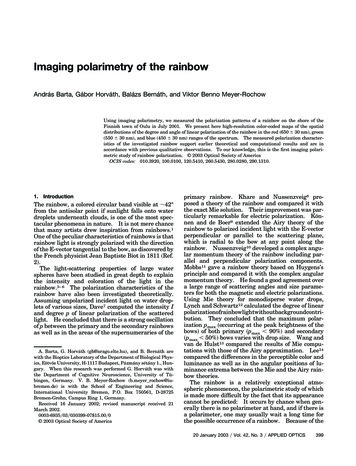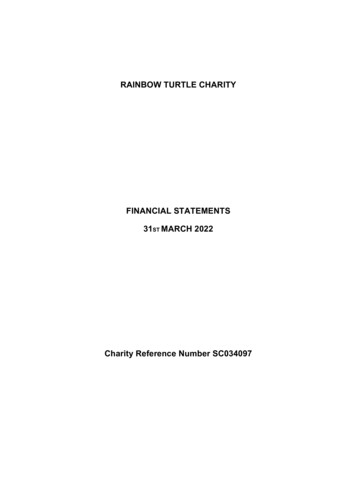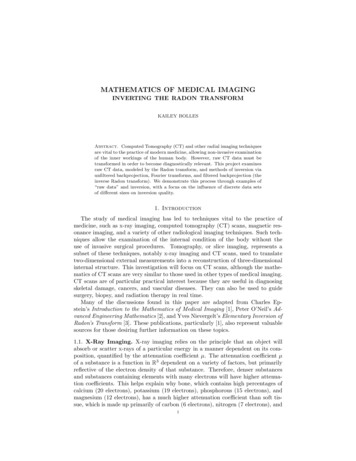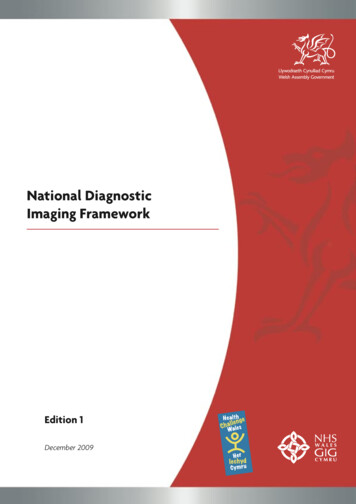
Transcription
Imaging polarimetry of the rainbowAndrás Barta, Gábor Horváth, Balázs Bernáth, and Viktor Benno Meyer-RochowUsing imaging polarimetry, we measured the polarization patterns of a rainbow on the shore of theFinnish town of Oulu in July 2001. We present here high-resolution color-coded maps of the spatialdistributions of the degree and angle of linear polarization of the rainbow in the red 共650 30 nm兲, green共550 30 nm兲, and blue 共450 30 nm兲 ranges of the spectrum. The measured polarization characteristics of the investigated rainbow support earlier theoretical and computational results and are inaccordance with previous qualitative observations. To our knowledge, this is the first imaging polarimetric study of rainbow polarization. 2003 Optical Society of AmericaOCIS codes: 010.3920, 100.0100, 120.5410, 260.5430, 280.0280, 290.1310.1. IntroductionThe rainbow, a colored circular band visible at 42 from the antisolar point if sunlight falls onto waterdroplets underneath clouds, is one of the most spectacular phenomena in nature. It is not mere chancethat many artists drew inspiration from rainbows.1One of the peculiar characteristics of rainbows is thatrainbow light is strongly polarized with the directionof the E-vector tangential to the bow, as discovered bythe French physicist Jean Baptiste Biot in 1811 共Ref.2兲.The light-scattering properties of large waterspheres have been studied in great depth to explainthe intensity and coloration of the light in therainbow.3– 6 The polarization characteristics of therainbow have also been investigated theoretically.Assuming unpolarized incident light on water droplets of various sizes, Dave7 computed the intensity Iand degree p of linear polarization of the scatteredlight. He concluded that there is a strong oscillationof p between the primary and the secondary rainbowsas well as in the areas of the supernumeraries of theA. Barta, G. Horváth 共gh@arago.elte.hu兲, and B. Bernáth arewith the Bioptics Laboratory of the Department of Biological Physics, Eötvös University, H-1117 Budapest, Pázmány sétány 1., Hungary. When this research was performed G. Horváth was withthe Department of Cognitive Neuroscience, University of Tübingen, Germany. V. B. Meyer-Rochow 共b.meyer rochow@iubremen.de兲 is with the School of Engineering and Science,International University Bremen, P.O. Box 750561, D-28725Bremen-Grohn, Campus Ring 1, Germany.Received 16 January 2002; revised manuscript received 21March 2002.0003-6935兾03兾030399-07 15.00兾0 2003 Optical Society of Americaprimary rainbow. Khare and Nussenzveig8 proposed a theory of the rainbow and compared it withthe exact Mie solution. Their improvement was particularly remarkable for electric polarization. Können and de Boer9 extended the Airy theory of therainbow to polarized incident light with the E-vectorperpendicular or parallel to the scattering plane,which is radial to the bow at any point along therainbow. Nussenzveig10 developed a complex angular momentum theory of the rainbow including parallel and perpendicular polarization components.Mobbs11 gave a rainbow theory based on Huygens’sprinciple and compared it with the complex angularmomentum theory. He found a good agreement overa large range of scattering angles and size parameters for both the magnetic and electric polarizations.Using Mie theory for monodisperse water drops,Lynch and Schwartz12 calculated the degree of ontribution. They concluded that the maximum polarization pmax 共occurring at the peak brightness of thebows兲 of both primary 共pmax 90%兲 and secondary共pmax 50%兲 bows varies with drop size. Wang andvan de Hulst13 compared the results of Mie computations with those of the Airy approximation. Lee14compared the differences in the perceptible color andluminance as well as in the angular positions of luminance extrema between the Mie and the Airy rainbow theories.The rainbow is a relatively exceptional atmospheric phenomenon, the polarimetric study of whichis made more difficult by the fact that its appearancecannot be predicted: It occurs by chance when generally there is no polarimeter at hand, and if there isa polarimeter, one may usually wait a long time forthe possible occurrence of a rainbow. Because of the20 January 2003 兾 Vol. 42, No. 3 兾 APPLIED OPTICS399
difficulties in observing rainbows, experimental research on the rainbow’s polarization characteristicsis scarce. Nevertheless, some experimental rainbowpolarization research has already been published.For example, using a polar nephelometer employing amonochromatic linearly polarized laser source, Sassen15 performed angular scattering measurementswith vertically and horizontally polarized incidentlight to examine the rainbow generation of pendantwater drops, a type of artificial near-spherical, vertically elongated particles, which model the distortedshapes of larger 共diameter, 0.3–1 mm兲 raindropswith circular cross section in the horizontal plane asthey fall. He measured linear polarization ratios asa function of scattering angle and compared the experimental data with theoretical predictions. Können16,17 published a pair of color photographs takenby A. B. Fraser of a rainbow viewed through a linearly polarizing filter: in the left and the right photographs the rainbow light was maximallytransmitted and extinguished, respectively. In the1991 Light and Color in the Open Air feature issue ofApplied Optics18 some rainbow photographs taken byA. B. Fraser through linearly polarizing filters werealso presented. Lee19 used these photographs to isolate the rainbow’s intrinsic colors, exploiting the factthat rainbow light is highly linearly polarized compared with light from the background: The rainbow’s perpendicular polarization component isdefined as that seen through a linear polarizer whenits transmission axis is perpendicular to the scattering plane determined by the Sun, a raindrop contributing to the bow, and the observer. At this polarizerorientation, the rainbow is the brightest. If the polarizer is rotated by 90 , the bow’s much weaker parallel polarization component is practically invisible.Light from the backround 共landscape and cloudy sky兲is usually almost unpolarized. Thus an estimate ofthe rainbow’s intrinsic colors 共without background兲can be obtained if the digitized image of a rainbow’sperpendicular polarized component is colorimetrically subtracted pixel by pixel from its parallel polarized counterpart.The polarization pattern of rainbows would be difficult to study by a point-source scanning polarimeter, because rainbows are spatially extended andexist for a short period. These patterns can be measured only with wide field-of-view imaging polarimetry. To our knowledge, imaging polarimetricinvestigations of rainbows have not been publisheduntil now. During one of our field trips we were ableto record the spatial distribution of the polarization ofa rainbow. Here we present the polarization patterns of this rainbow measured in the red, green, andblue ranges of the spectrum.2. Materials and MethodsOur team was lucky enough to get over all the difficulties in measuring the polarization patterns of arainbow. When on 18 July 2001 at 17:42 共local summer time, UTC 3; solar elevation, 29 41 兲 wewaited for a boat at the ferry port of the Finnish town400APPLIED OPTICS 兾 Vol. 42, No. 3 兾 20 January 2003of Oulu 共65 0 N, 25 26 E兲, a beautiful rainbow occurred above the sea surface to the northeast. Sinceour 180 imaging polarimeter was at hand, becausewe were going to perform full-sky polarimetric measurements on the island of Hailuoto, we were able totake two triplets of polarization pictures from thisrainbow with different exposures. Unfortunately,because of great haste, the color reversal film was putincorrectly into the roll-film camera of the polarimeter, and therefore the film was blocked after the firstsix photographs. Fortunately, one of the two triplets was successful with an optimal aperture and exposure combination. Then, on the way to Budapest,where the evaluation procedure was to be completed,one of the present authors 共Bernáth兲 unfortunatelyforgot the hand luggage containing the developed filmat Vantaa Airport in Helsinki while changing planes.Fortunately, Jari Toivonen 共international liaison officer of Finnair兲 found this luggage and kindly sentthe film to Budapest. This single successful tripletof polarization pictures is the basis for the polarization patterns presented in this study.The polarization characteristics of the rainbowwere measured in the red 共650 30 nm兲, green共550 30 nm兲, and blue 共450 30 nm兲 ranges of thespectrum by a one-lens, one-camera, 180 field-ofview, rotating-analyzer imaging polarimeter. Theoptical axis of the fish-eye lens was horizontal andpointed toward the antisolar part of the horizon.The polarimeter, its calibration, and the whole evaluation procedure are described in detail elsewhere.20Here we mention only that the polarimeter is composed of a Nikon F801 roll-film camera equipped witha Nikon-Nikkor fish-eye lens 共f-number, 2.8; focallength, 8 mm; angle of view, 180 兲 including a built-infilter wheel with three neutral gray linearly polarizing filters 共type name HNP’B, Polaroid Corporation兲with three different polarization axes 共 0 , 45 , 90 from the radius of the wheel兲. As a detector we useda Fujichrome Sensia II 100 ASA color reversal film.The spatial distributions of the measured degree oflinear polarization p 共Imax Imin兲兾共Imax Imin兲—where Imax and Imin are the maximum and the minimum of radiance, respectively, transmitted throughthe polarizer—and angle of polarization 共angle ofthe major axis of the polarization ellipse measuredfrom the radius of the circular picture taken by the180 field-of-view fish-eye lens of the polarimeter兲 arepresented here in the form of high-resolution, twodimensional, color-coded maps.After evaluation of the color slides, we experiencedthat the observed 共background included兲 degree ofpolarization of the primary rainbow was 20 –25%,which is much less than what one would expect fromtheory for the intrinsic 共background excluded兲 polarization of rainbow light 共that is, for a rainbow seenagainst a hypothetic black background兲.2,7–14 Theexplanation of this is that we did not measure theintrinsic polarization of rainbow light alone, but thenet degree of polarization of the mixture of the rainbow light and the unpolarized or weakly polarizedlight from the cloudy sky background. According to
Fig. 1. 180 field-of-view color photograph of the shore of Oulu 共65 0 N, 25 26 E, Finland兲 with a rainbow above the sea surface 共A兲 andthe patterns of radiance I 共B, E, H兲, degree of linear polarization p 共C, F, I兲 and angle of polarization 共D, G, J兲 measured by 180 imagingpolarimetry on 18 July 2001, at 17:42 共local summer time, UTC 3兲, in the blue 共450 30 nm兲, green 共550 30 nm兲, and red 共650 30nm兲 spectral ranges, when the solar elevation was 29 41 above the horizon. Time of exposure, 1兾250 s; aperture, 5.6; detector,Fujichrome Sensia II; 100 ASA color reversal film. At a given point of the circular patterns, is measured clockwise from the radius. Theblack bars in the patterns show the local direction of polarization at points of a quadratic grid.Lee,19 the light from the background desaturates anddepolarizes the bow’s intrinsic colors and polarizationmarkedly. To estimate the degree of polarization ofthe rainbow light, we filtered the contribution of thebackground light in the following way: First weevaluated the raw polarization color pictures with themethod described in Refs. 20 and 21. Then we determined an average radiance Iav of the sky background in the immediate vicinity of the primaryrainbow, where Iav is the radiance if the polarizer’s20 January 2003 兾 Vol. 42, No. 3 兾 APPLIED OPTICS401
Fig. 2. 共A–C兲 Enlarged rectangular parts of the three polarization color pictures of the rainbow in Fig. 1 taken through a linear polarizerwith three different orientations 共measured from the vertical兲 of the transmission axis 共E-vector兲. 共D兲 The averaged color picture 共ascould be seen by the human eye or could be photographed without a polarizer兲 computed from the three polarization pictures.transmission axis is perpendicular to the E-vectordirection in the investigated point. After subtraction of Iav from the measured radiance at each pointof the picture, the usual evaluation process was performed again for the whole picture. The plots in Fig.4 are obtained after this subtraction.3. ResultsFigure 1A shows the 180 field-of-view color picture共reconstructed from the three color photographstaken through a linear polarizer with three differenttransmission axes兲 at the shore of Oulu with a rainbow above the sea surface. In the foreground 共bottom and right near the periphery兲 the barriers of anasphalt road, a reef of rocks, and the shadow of theobserver and the polarimeter are visible. The skyabove the observer is clear, but above the horizon thedisappearing cumulonimbus clouds of a rainstormare seen. The rainbow above the sea surface is produced by sunlight scattered by water droplets of thisthunderstorm. Figures 1B–1J show the patterns of402APPLIED OPTICS 兾 Vol. 42, No. 3 兾 20 January 2003radiance I, degree of linear polarization p, and angleof polarization measured at 450, 550, and 650 nm.Figures 2A–2C show enlarged rectangular parts ofthe three polarization pictures of the rainbow. InFig. 2D the reconstructed color picture of the rainbowis visible as can be seen by the human eye or can bephotographed without a polarizer. Figures 2A–2Cdemonstrate how strongly polarized the sunlight reflected from the rain drops is and that the direction ofpolarization is parallel to the rainbow: As the polarizer rotates, parts of the rainbow are invisible,because the polarizer does not transmit the component of the electric field vector of the highly polarizedrainbow light, which is perpendicular to its transmission axis. In Fig. 3 we see the rainbow in rectangular enlarged windows of the patterns in Fig. 1. Theplots in Fig. 4 represent the p and values measuredat 450, 550, and 650 nm as a function of the angle ofelevation along the vertical arrows in Fig. 3 aftersubtraction of the contribution of light from the skybackground.
Fig. 3. Patterns of radiance I 共A, D, G兲, degree of linear polarization p 共B, E, H兲 and angle of polarization 共C, F, I兲 of the rainbow in Fig.2 measured in the blue 共450 nm兲, green 共550 nm兲, and red 共650 nm兲 spectral ranges. measured clockwise from the radius and p areshown in the color wheel and gray-scale bar in Fig. 1, respectively. The black bars in the patterns show the local direction ofpolarization. The plots in Fig. 4 are based on data measured along the vertical arrows B, C, E, F, H, I.In the patterns of I 共Figs. 1B, 1E, 1H; 3A, 3D, 3G兲and p 共Figs. 1C, 1F, 1I; 3B, 3E, 3H; 4A, 4C, 4E兲 onecan see that the rainbow shows up most strikingly at650 nm 共red兲, whereas at 450 nm 共blue兲 it is hardlyvisible. In the red part of the spectrum, in the ppattern 共Figs. 1I, 3H, 4E兲 also the arc of the secondarybow is discernible. In the p patterns 共Figs. 1C, 1F,1I兲 we see that the light scattered by the clouds isalmost unpolarized and that there is great contrast inp between them and the blue sky as well as thestrongly polarized sea surface. At 650 nm the primary rainbow is as highly polarized as the watersurface in the foreground. In the direction crossingthe primary rainbow upward, there is an abrupt decrease of p: At 650 nm, for example, p decreasesfrom 50% of the primary rainbow to 5% of Alexander’s dark band between the primary and the secondary rainbows. The light in Alexander’s darkband is unpolarized, because the background skylight is unpolarized. Lee19 and Gedzelman22 discussed the role of the background skylight inobservations of the rainbow in the sky. In the direction downward from the primary rainbow, p gradually decreases with some oscillations 共Figs. 1I, 3H,4E兲. These oscillations are due to the supernumerary rainbows.At all three wavelengths 共450, 550, 650 nm兲, in the patterns 共Figs. 1D, 1G, 1J; 3C, 3F, 3I兲 and plots共Figs. 4B, 4D, 4F兲 the rainbow does not show up,which demonstrates that there is no angle of polarization contrast between the rainbow and its celestialbackground. The situation is similar to the clouds:In the patterns the clouds show up most strikinglyin the red spectral range 共Fig. 1J兲, but they are hardlyvisible in the blue part of the spectrum 共Fig. 1D兲.The sea surface reflects highly and horizontally polarized light, independently of wavelength 共Fig. 1兲.4. DiscussionThe primary rainbow observed by us, as is usual forrainbows, was red outside and blue inside, and theinnermost colors were paler than the red. At 11 outside the primary rainbow, a secondary rainbowwith a reversed sequence of colors appeared, whichwas much fainter than the primary one. A few supernumerary rainbows were also visible below theprimary bow. The investigated rainbow was seen,because the entire sky under the cumulonimbuscloud was filled with water droplets, and all of themwere lit by the Sun.According to Können and de Boer9 as well as Können,2 the strong polarization of the rainbow is theconsequence of the path that the beams of light generating the rainbow follow in the drops: In the primary or secondary rainbow, the beams experienceone or two reflections in the drop, respectively.Since these reflections happen at angles very near theBrewster angle, the reflected light is highly polarized,and the direction of polarization is always perpendicular to the scattering plane, which is radial to the arcof the bow. Since the light below the primary rainbow and above the secondary one rises in the sameway as the light of the rainbow itself, its direction ofpolarization is also tangential to the bow. Thoughthe scant light from the Alexander’s band betweenthe primary and the secondary rainbow arises from20 January 2003 兾 Vol. 42, No. 3 兾 APPLIED OPTICS403
Fig. 4. Degree of linear polarization p 共A, C, E兲 and angle of polarization 共B, D, F兲 in the blue 共450 nm兲, green 共550 nm兲, and red 共650nm兲 spectral ranges as a function of the angle of elevation 共horizontal axis兲 measured along the vertical arrows shown in Fig. 3 共pointingfrom bottom 0 to top 28 兲 after subtraction of the contribution of light from the sky background. is measured clockwise fromthe radius of the original circular picture in Fig. 1.reflections from the outside surface of the water droplets, background skylight plays a large role, too.This light is also tangentially polarized with respectto the bows.Hence the direction of polarization of sunlight returned by the primary and the secondary rainbows,as well as by the celestial regions below the primaryrainbow, between the primary and the secondarybows and above the secondary bow is always perpendicular to the scattering plane, that is, tangential tothe bows. Thus there is no angle of polarizationcontrast between the rainbows and their sunlit celestial surroundings, which usually is also characterized404APPLIED OPTICS 兾 Vol. 42, No. 3 兾 20 January 2003by E-vectors perpendicular to the scattering plane.This effect is discussed in detail by Können.2 This iswhy the rainbow does not show up in the patternsand the plots. The same phenomenon was recently observed by Pomozi et al.,21 who demonstratedby full-sky imaging polarimetry that the clear-skyangle of polarization pattern continues underneathclouds if they and the underlying air layer are lit bydirect sunlight. Under this illumination conditionthere is no angle of polarization contrast between theclouds and the blue sky 共see also the patterns in Fig.1兲.Our observation, that in the I and the p patterns
the investigated rainbow showed up best in the redpart of the spectrum, but was hardly visible in theblue spectral range, can be explained by the logicalassumption that the background light was unpolarized or only very weakly polarized as a result of multiple scattering, and it was most intensive in the bluespectral range because of Rayleigh scattering; therefore it could most strongly desaturate and depolarizethe colored and polarized rainbow light in the bluepart of the spectrum. Furthermore, the partially polarized light scattered in the air column between theobserver and the rainbow, which is most intense inthe blue, partly overwhelms the rainbow light, especially in the blue 共see Figs. 4A, 4C, and 4E兲.Gedzelman22 developed a model for the brightnessand coloration of rainbows that takes into account thecloud geometry and solar elevation with respect tothe observer. The model consists of a beam of singlyscattered sunlight that experiences depletion as itpasses through the atmosphere and rainswath. Itexplains why the bottom of the rainbow tends to beboth brighter and redder than the top when the Sunis near the horizon. Then the brightness of the bottom of the bow is affected most from scattering orabsorption of light within the atmosphere. This isespecially true for short wavelengths or for hazy conditions. One consequence is that the bottom is reddened in comparison with the top. The entire bowmay be red when the Sun is at the horizon. Sinceour measurement was done at a relatively high solarelevation 共29 41 兲, this effect cannot explain why therainbow that we investigated was most striking at650 nm in both the I and the p patterns.The optical phenomena associated with the rainbow are complex because of 共i兲 diffraction of light bythe raindrops, 共ii兲 internal reflections within thedrops, 共iii兲 reflections from the outside surface of thedrops, and 共iv兲 interference of light. Further experimental research is needed to understand how thesephenomena determine the polarization characteristics of the rainbow and to test the theoretical, computational predictions on rainbow polarization.We conclude the following: Owing to several fortunate circumstances, we were able to perform whatwe believe is the first imaging polarimetric study of arainbow. The patterns of the degree and angle oflinear polarization of the rainbow were measured andvisualized at 450, 550, and 650 nm. The measuredpolarization characteristics of the investigated rainbow support earlier theoretical and computationalresults and are in accordance with previous qualitative observations.This research was supported by a Humboldt research fellowship from the German Alexander vonHumboldt Foundation and by an István Széchenyifellowship from the Hungarian Ministry of Educationto G. Horváth. Further grants came from Oulu University and the Nowotka KG Bremen to V. B. MeyerRochow. We are grateful to R. Wehner 共Institute ofZoology, University of Zurich, Switzerland兲 for loaning his Nikon-Nikkor fish-eye lens. Many thanksare due to Jari Toivonen 共international liaison officer,Finnair兲, who found and kindly sent us our lost luggage with the polarization pictures of the rainbowpresented in this study to Budapest. Many thanksare due to two reviewers for their valuable and constructive comments.References1. R. L. Lee, Jr., and A. B. Fraser, The Rainbow Bridge: Rainbows in Art, Myth, and Science 共Pennsylvania State University, Philadelphia, 2001兲.2. G. P. Können, Polarized Light in Nature 共Cambridge University, Cambridge, UK, 1985兲.3. M. Minnaert, Light and Color in the Open Air 共Bell, London,1940兲.4. R. A. R. Tricker, Introduction to Meteorological Optics共Elsevier, New York, 1970兲.5. R. Greenler, Rainbows, Halos, and Glories 共Cambridge University, Cambridge, UK, 1980兲.6. K. L. Coulson, Polarization and Intensity of Light in the Atmosphere 共Deepak, Hampton, Va., 1988兲.7. J. V. Dave, “Scattering of visible light by large water spheres,”Appl. Opt. 8, 155–164 共1969兲.8. V. Khare and H. M. Nussenzveig, “Theory of the rainbow,”Phys. Rev. Lett. 33, 976 –980 共1974兲.9. G. P. Können and J. H. de Boer, “Polarized rainbow,” Appl.Opt. 18, 1961–1965 共1979兲.10. H. M. Nussenzveig, “Complex angular momentum theory ofthe rainbow and the glory,” J. Opt. Soc. Am. 69, 1068 –1079共1979兲.11. S. D. Mobbs, “Theory of the rainbow,” J. Opt. Soc. Am. 69,1089 –1092 共1979兲.12. D. K. Lynch and P. Schwartz, “Rainbows and fogbows,” Appl.Opt. 30, 3415–3420 共1991兲.13. R. T. Wang and H. C. van de Hulst, “Rainbows: Mie computations and the Airy approximation,” Appl. Opt. 30, 106 –117共1991兲.14. R. L. Lee, “Mie theory, Airy theory, and the natural rainbow,”Appl. Opt. 37, 1506 –1519 共1998兲.15. K. Sassen, “Angular scattering and rainbow formation in pendant drops,” J. Opt. Soc. Am. 69, 1083–1089 共1979兲.16. G. P. Können, “Viewing our world with polarizing glasses,”Endeavour 共new series兲 10共3兲, 121–124 共1986兲.17. G. P. Können, “Polarization in nature,” in Direct and InverseMethods in Radar Polarimetry. Part I. W.-M. Boerner, ed.共Kluwer, Amsterdam, 1992兲, pp. 33– 44.18. Light and color in the open air, feature issue, J. A. Lock, ed.,Appl. Opt. 30, 3381–3552 共1991兲.19. R. L. Lee, “What are ‘all the colors of the rainbow’?” Appl. Opt.30, 3401–3407 共1991兲.20. J. Gál, G. Horváth, V. B. Meyer-Rochow, and R. Wehner, “Polarization patterns of the summer sky and its neutral pointsmeasured by full-sky imaging polarimetry in Finnish Laplandnorth of the Arctic Circle,” Proc. R. Soc. London Ser. A 457,1385–1399 共2001兲.21. I. Pomozi, G. Horváth, and R. Wehner, “How the clear-skyangle of polarization pattern continues underneath clouds:full-sky measurements and implications for animal orientation,” J. Exp. Biol. 204, 2933–2942 共2001兲.22. S. D. Gedzelman, “Rainbow brightness,” Appl. Opt. 21, 3032–3037 共1982兲.20 January 2003 兾 Vol. 42, No. 3 兾 APPLIED OPTICS405
Imaging polarimetry of the rainbow Andra s Barta, Ga bor Horva th, Bala zs Berna th, and Viktor Benno Meyer-Rochow Using imaging polarimetry, we measured the polarization patterns of a rainbow on the shore of the Finnish town of Oulu in July 2001. We present here high-resolution color-coded maps of the spatial










